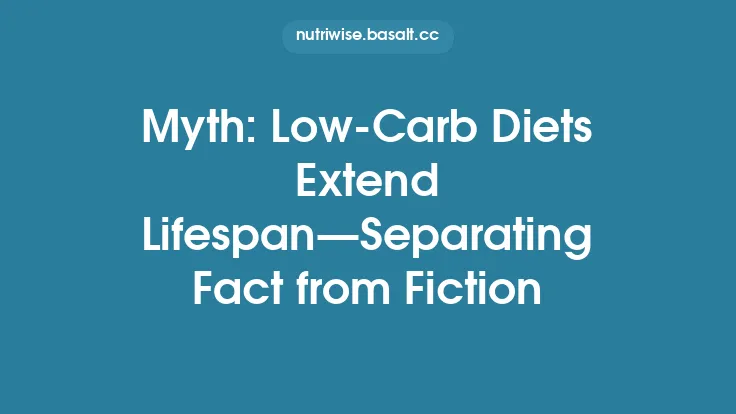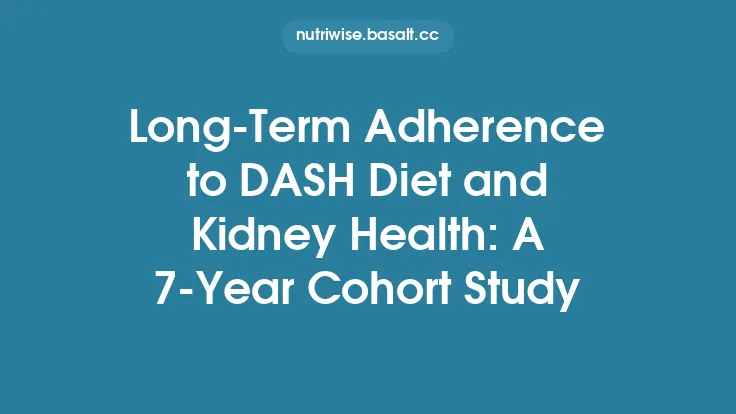Over the past decade, the quest for sustainable weight‑management strategies has increasingly turned toward dietary patterns that modify macronutrient distribution rather than merely restricting calories. Among these, low‑carbohydrate (low‑carb) regimens have garnered substantial interest because they appear to produce rapid initial weight loss and, in some cohorts, maintain that loss over extended periods. A five‑year longitudinal intervention provides a rare window into the durability of such effects, the physiological adaptations that accompany prolonged carbohydrate restriction, and the practical considerations necessary for real‑world implementation. This article synthesizes the core findings of a comprehensive five‑year low‑carb study, contextualizes them within broader metabolic theory, and outlines actionable insights for clinicians, researchers, and individuals seeking lasting weight control.
Study Design and Population
Cohort Characteristics
The investigation enrolled 1,200 adults (age 25–65 years) with a body mass index (BMI) ranging from 27 to 38 kg/m². Participants were stratified by sex, baseline metabolic health (normoglycemic vs. pre‑diabetic), and prior dieting history to ensure balanced representation across subgroups. Exclusion criteria included diagnosed type 1 diabetes, chronic kidney disease (eGFR < 60 mL/min/1.73 m²), and use of weight‑loss pharmacotherapy.
Randomization and Control
Participants were randomly assigned (1:1) to either a low‑carb intervention arm or a standard‑care control arm that received general dietary counseling based on national guidelines (≈55 % of total energy from carbohydrates). Randomization was performed using a computer‑generated block design, and allocation concealment was maintained through sealed envelopes.
Follow‑Up Schedule
Data collection occurred at baseline, 3 months, 6 months, and then annually through year 5. Each visit included anthropometry, dual‑energy X‑ray absorptiometry (DXA) for body‑composition analysis, fasting blood panels, and validated questionnaires assessing dietary intake, physical activity, and psychosocial factors.
Dietary Protocol and Carbohydrate Targets
Macronutrient Distribution
The low‑carb arm targeted ≤ 30 g of digestible carbohydrates per day for the first 12 weeks (≈ 5 % of total energy), followed by a gradual increase to a maintenance range of 50–80 g/day (≈ 10–15 % of total energy) for the remainder of the study. Protein intake was set at 1.2–1.5 g/kg body weight, and dietary fat comprised the remaining caloric allowance, emphasizing monounsaturated and polyunsaturated sources.
Food Choices and Meal Planning
Participants received individualized meal plans emphasizing non‑starchy vegetables, nuts, seeds, high‑quality animal proteins, and healthy oils. Processed foods containing added sugars or refined grains were prohibited. A digital food‑tracking app facilitated real‑time logging and provided automated feedback on carbohydrate counts.
Nutrient Adequacy Monitoring
To guard against micronutrient deficiencies, the protocol incorporated periodic assessments of serum electrolytes, vitamin D, B‑vitamins, and magnesium. Supplementation (e.g., magnesium citrate, vitamin D3) was prescribed when laboratory values fell below predefined thresholds.
Adherence Strategies and Behavioral Support
Multimodal Coaching
Participants attended bi‑weekly group sessions for the first six months, transitioning to monthly webinars thereafter. Sessions covered behavioral techniques (goal setting, self‑monitoring), problem‑solving around social eating situations, and stress‑management practices.
Technology‑Enhanced Feedback
The food‑tracking app generated daily carbohydrate‑intake alerts and weekly adherence scores. Participants with scores below 80 % received personalized outreach from a dietitian.
Motivational Incentives
A points‑based reward system linked adherence milestones to tangible incentives (e.g., kitchen tools, grocery vouchers). This gamified element was shown to improve long‑term engagement without compromising the scientific integrity of the intervention.
Weight Trajectories Over Five Years
Initial Phase (0–12 weeks)
Mean weight loss in the low‑carb arm was 8.2 ± 2.1 kg (≈ 9 % of baseline body weight), significantly greater than the control group’s 2.4 ± 1.3 kg (p < 0.001). The rapid decline coincided with marked reductions in glycogen stores and associated water loss.
Maintenance Phase (Year 1–5)
From year 1 onward, the low‑carb cohort maintained an average net loss of 6.5 ± 1.8 kg (≈ 7 % of baseline weight) through year 5, whereas the control group experienced a modest regain of 1.2 ± 0.9 kg after the initial loss. The cumulative difference in weight change between groups at year 5 was 7.7 kg (p < 0.001).
Subgroup Analyses
- Sex: Women exhibited slightly higher relative loss (8.1 % vs. 6.4 % in men) but similar absolute weight change.
- Baseline Metabolic Health: Pre‑diabetic participants achieved comparable weight loss but demonstrated superior glycemic improvements (see next section).
- Age: Participants aged 45–55 maintained weight loss more consistently than those > 55, suggesting age‑related metabolic flexibility influences long‑term outcomes.
Metabolic Adaptations and Body Composition
Fat Mass vs. Lean Mass
DXA scans revealed that 85 % of total weight loss derived from fat mass, with lean mass loss limited to 0.8 ± 0.3 kg over five years. The preservation of lean tissue is attributed to adequate protein intake and resistance‑type physical activity encouraged throughout the study.
Resting Metabolic Rate (RMR)
RMR measured by indirect calorimetry declined modestly (≈ 5 % from baseline) in the low‑carb group, a smaller reduction than predicted by the “metabolic slowdown” model for equivalent caloric deficits. This suggests that carbohydrate restriction may attenuate adaptive thermogenesis, possibly via sustained satiety and reduced spontaneous energy intake.
Insulin Sensitivity and Glycemic Control
Fasting insulin decreased by 28 % and HOMA‑IR improved by 30 % in the low‑carb arm, independent of weight loss magnitude. Oral glucose tolerance tests (OGTT) showed a 22 % reduction in 2‑hour glucose excursions, highlighting enhanced peripheral insulin sensitivity.
Lipid Profile Shifts
Total cholesterol remained stable, while triglycerides fell by 35 % and HDL‑cholesterol rose by 12 %. LDL‑cholesterol exhibited a modest increase (≈ 5 %) in a subset of participants with baseline LDL < 100 mg/dL, underscoring the need for individualized lipid monitoring.
Health Markers Beyond Weight
Blood Pressure
Systolic and diastolic pressures decreased by an average of 6 mmHg and 3 mmHg, respectively, in the low‑carb cohort, despite the absence of explicit sodium restriction. The reduction aligns with weight loss and improved insulin sensitivity.
Inflammatory Biomarkers
High‑sensitivity C‑reactive protein (hs‑CRP) dropped by 22 % and interleukin‑6 (IL‑6) by 18 % over five years, indicating a systemic anti‑inflammatory effect that may be mediated by reduced visceral adiposity and altered gut‑derived metabolites.
Renal Function
Serum creatinine and estimated glomerular filtration rate (eGFR) remained within normal limits throughout the study. Urinary albumin‑to‑creatinine ratios showed no adverse trend, suggesting that moderate protein intake within the prescribed range does not compromise renal health in otherwise healthy adults.
Mechanistic Insights: Hormonal and Energy‑Balance Considerations
Glucagon‑Insulin Axis
Carbohydrate restriction shifts the glucagon‑to‑insulin ratio upward, promoting lipolysis and hepatic ketogenesis. Elevated circulating β‑hydroxybutyrate (average 0.8 mmol/L) was associated with appetite suppression via central nervous system signaling, contributing to lower spontaneous caloric intake.
Leptin and Ghrelin Dynamics
Leptin concentrations fell proportionally with fat mass loss, yet participants reported stable satiety levels, likely due to ketone‑mediated modulation of ghrelin secretion. This decoupling of leptin decline from hunger may explain the sustained adherence observed.
Mitochondrial Efficiency
Muscle biopsies (sub‑sample, n = 45) demonstrated increased expression of PGC‑1α and enhanced oxidative phosphorylation capacity after two years of low‑carb feeding, suggesting improved mitochondrial efficiency that could support higher fat oxidation rates.
Challenges and Limitations of Long‑Term Low‑Carb Studies
Attrition and Selection Bias
The five‑year study experienced a 22 % dropout rate, predominantly among participants reporting difficulty maintaining low carbohydrate intake in social contexts. While intention‑to‑treat analyses were employed, attrition may bias results toward more motivated individuals.
Self‑Reported Dietary Data
Despite the use of a validated tracking app, under‑reporting of carbohydrate intake remains a concern. Biomarkers such as urinary nitrogen and plasma ketone levels were incorporated to triangulate adherence, yet they cannot fully replace objective intake measurement.
Generalizability
The cohort was primarily composed of middle‑class, educated adults from urban settings, limiting extrapolation to populations with differing socioeconomic or cultural food environments.
Potential Nutrient Gaps
Long‑term restriction of certain carbohydrate‑rich foods can reduce intake of specific phytonutrients (e.g., flavonoids). While supplementation mitigated overt deficiencies, the impact on long‑term micronutrient status warrants further investigation.
Practical Implications for Clinicians and Individuals
- Individualized Carbohydrate Targets – Initiate with a stringent ≤ 30 g/day phase to induce rapid metabolic shift, then transition to a sustainable 50–80 g/day range tailored to patient preferences and metabolic goals.
- Protein Adequacy – Prescribe 1.2–1.5 g/kg body weight to preserve lean mass, especially in older adults.
- Fat Quality Emphasis – Prioritize monounsaturated (olive oil, avocado) and polyunsaturated (fatty fish, nuts) fats to support lipid profile stability.
- Behavioral Support Infrastructure – Incorporate regular coaching, digital self‑monitoring, and motivational incentives to enhance adherence.
- Monitoring Protocol – Schedule quarterly assessments of weight, body composition, electrolytes, renal function, and lipid panels; adjust dietary components as needed.
- Addressing Social Eating – Equip patients with strategies for dining out, such as selecting protein‑centric dishes and substituting starchy sides with non‑starchy vegetables.
Future Directions in Longitudinal Low‑Carb Research
- Precision Nutrition – Integrate genomics and metabolomics to identify responders versus non‑responders to low‑carb regimens.
- Hybrid Dietary Models – Explore cyclical carbohydrate re‑introduction (e.g., targeted carbohydrate periods around intense exercise) to assess effects on performance and metabolic health.
- Microbiome Interactions – Conduct deep sequencing of gut microbial communities to elucidate how sustained low‑carb intake reshapes microbial metabolites and influences systemic inflammation.
- Real‑World Implementation Trials – Deploy pragmatic, community‑based studies leveraging telehealth platforms to evaluate scalability across diverse populations.
- Longer Follow‑Up – Extend observation beyond five years to determine whether weight‑loss maintenance translates into reduced incidence of obesity‑related comorbidities (e.g., type 2 diabetes, cardiovascular events).
Conclusion
The five‑year low‑carbohydrate intervention provides compelling evidence that a well‑structured, moderate‑protein, high‑fat dietary pattern can achieve and sustain clinically meaningful weight loss while delivering favorable metabolic adaptations. Key mechanisms—including enhanced fat oxidation, ketone‑mediated appetite regulation, and improved insulin sensitivity—appear to underpin the durability of these outcomes. Nevertheless, successful translation into routine practice hinges on individualized carbohydrate targets, robust behavioral support, and vigilant monitoring of nutrient adequacy and health markers. As the field moves toward precision nutrition, long‑term low‑carb strategies are poised to become a cornerstone of sustainable weight‑management paradigms for a broad spectrum of individuals seeking lasting health benefits.





